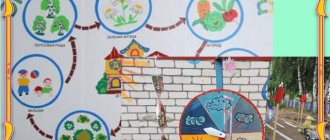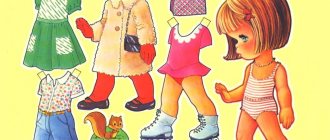Summary of educational activities using didactic games for children with disabilities Topic: “Colorful little house”
2
Appendix 45
Lesson notes on sensory development
using didactic games for children of the second junior group
Topic: “Multi-colored little mansion” Goal –
develop children's sensory abilities through didactic games developed by me.
Tasks:
- Continue to introduce the properties of objects and their characteristics.
- Develop fine motor skills of the hands, logical thinking, memory, geometric shapes, knowledge of primary colors, tactile sensations, eye, speech.
- Strengthen the ability to identify and name the color of objects. Group objects by color.
- Strengthen the ability to focus on 2 signs at the same time (color, shape)
- Reinforce the concept of “big” and “small”.
- Form attention, thinking, imagination, memory.
- Develop auditory perception.
- Develop fine motor skills.
- Develop coherent speech.
- Foster friendly relationships between children.
Materials and equipment:
A model of a tower with windows in which pictures of animals (wild and domestic) are pasted, around which geometric shapes are pasted, lids on which are depicted geometric shapes and which are screwed onto the windows, mosaic and cardboard.
1. Introduction to gaming activities.
Educator: - Guys, I invite everyone to play.
Finger game “Teremok” (children repeat words and actions)
There is a mansion in a field, There is a lock on the door. The wolf wanted to open the lock - Twitch-tug, twitch-tug... The Puppy came and opened the lock with the key.
- I wonder who lives in this little house?
(children's assumptions) Puppy. It was he who opened the door with the key. 2. Play activity
Finger game “Knock-knock” (children repeat words and actions)
- Knock-knock-knock... - Yes-yes-yes... - Can I come to you? - I'm always glad! - Look, these are our old familiar colored people. Let's remember what their names are (the teacher shows one at a time, and the children name the little men) (Blue, Green, Red, Yellow) - Well done, guys, haven't forgotten. People of color not only came to us, they need our help. They wanted to go visit the little animals living in the tower, but they don’t know where or whose house it is. They ask you to find and correctly indicate where and whose house is. Let's help our friends? Children's answers.
Game "find your house"
Educator: Look, on your table there are lids on which geometric shapes are depicted. - Tell me what figure is on the lid? Children's answers (square, triangle, rectangle, circle, oval, all small) - Correct. Now look at our little mansion. Children's answers (there are large figures on it) Educator: Let's screw on the lid with the correct figure for the large figures that are depicted on the tower. Children take a lid with a figure, name the color of the figure that is depicted on it and screw it to an equally large figure on the tower. Educator: One by one, ask the children to describe our little house, naming the color and shape of the part (2-3 children). Our friends are very glad that we helped them visit the little animals that live in the little house. They invite you to have fun with them.
Physical education minute.
Two claps above your head, two claps in front of you, we will hide two hands behind our back, and we will jump on two legs.
Teacher, guys, look, there are berries, mushrooms, apples and cardboard baskets laid out on the floor. V. – Oh, let’s collect gifts for our friends from the tower. D. - Gifts! V. – Correct. What do they like? D. – Mushrooms, berries. V. - Well done! Look, different berries, mushrooms, and fruits grow in the clearing. Let's collect them for them!
Game "Sort by color"
Educator: And now our friends and residents of the tower invite us to play, imagine that the mosaic is berries, and the sheets of cardboard are baskets. A blue leaf is a blue basket, a yellow leaf is a yellow basket, etc. Look at how many berries there are (mosaics). You need to quickly collect all the “berries” in your “baskets” - red “berries” - in the red “basket”, green “berries” - in the green “basket”, blue “berries” in the blue “basket”, and yellow “berries” in the yellow “basket”. Children lay out the mosaic on appropriate sheets of cardboard. After completion, we check to see if any unsuitable berries were included in the baskets. 3. Summary of the lesson.
Educator: These guys are great! Well done. — How did you help our friends and the little animals in the tower? We found our own house for everyone and played a game. And all because you know colors and shapes well.
Didactic game on cognitive development for children of the preparatory group of preschool educational institutions
Summary of the game “What will be what?”
for children of the preparatory group for school Author: Likhovidova Sofya Mikhailovna. Position, place of work: student at Veshensky Pedagogical College named after. M.A. Sholokhov", specialty "Preschool education", Rostov region, Sholokhovsky district, Veshenskaya village. Description of the material: a summary of the game has been prepared for children in the preparatory school group. The didactic game is aimed at developing the cognitive interests of children (OO Cognitive Development). This summary may be of interest to both teachers of preschool educational organizations and students studying in the specialty “Preschool Education”. Group: preparatory. Goal: formation of cognitive actions. Didactic tasks: improve the ability to establish simple connections between subjects; continue to promote the development of the ability to think logically and answer questions in complete sentences; practice naming objects correctly. Developmental objectives: to promote the activation of children's speech; promote the development of memory, attention, thinking. Educational objectives: create conditions for nurturing independence, friendly relations in the group, respect for each other. Game task: answer what will be and what was. Game rules: catch the ball, answer the question, do not shout. Game actions: line up in a circle, catch the ball, answer a question. Equipment: ball, Dunno. Preliminary work: looking at illustrations, talking with children, watching videos, observing while walking.
Progress of the game
Educator: Hello, guys! My name is Sofya Mikhailovna. I am glad to see you all cheerful and healthy. Guys, do you know who I met near the gate of your kindergarten? I met Dunno (a crying Dunno enters the group)
.
Guys, let's ask him why he's crying? Children: Let's go. Educator: Dunno, answer us, why are you so sad? Dunno: I really like to play different games, but I can’t do a lot of things. That's why no one wants to play with me. Educator: Dunno, what game is causing you difficulties? Dunno: I can’t always answer the question in the game “What will be what?” Educator: Guys, can we help Dunno? Shall we play his favorite game with him? Children: Yes. Educator: Then for this we’ll take a ball. Dunno, stand in a circle with the guys. I will throw a ball to each of you and say a word, and you will have to answer what comes of it. Well, for example: an egg can produce a chicken, a bud can produce a leaf, and so on. The one with the ball in his hands answers; the others do not shout out. Guys, do you understand everything? Children: Yes. Educator: Dunno, if you find it difficult to answer, we will help you all together. Dunno: Okay! Educator: So, let's begin: Calf - cow Foal - horse Acorn - oak Caterpillar - butterfly Flour - dough / bread Chick - bird Lamb - sheep Leather - shoe Fabric - dress Board - closet Child - adult Educator: Well done, guys ! How much new things our Dunno will learn. Now let's do the opposite: I will say the word, and you will name what it used to be. For example: The table used to be a board, or the frog was a tadpole. Guys, do you understand everything? Children: Yes Teacher: Okay, let's continue: Dog - puppy House - brick Man - boy Mittens - wool Fish - egg Cat - kitten Plant - seed Goat - kid Paper - wood Glass - sand Pig - piglet Teacher: Guys, what a great job you are! Now our Dunno can play this game with his friends, because he has learned so many new things. Dunno: Yes, guys, thank you very much! Thanks to you, I have become smarter! And now, I ran to my friends. Goodbye! (Dunno leaves)
.
Children: Goodbye. Educator: Guys, what new game did you learn today? What is it called? Children: “What will happen?” Educator: Let's remember what paper used to be? What was glass? Well done guys, you worked really hard today. Dunno was very pleased!
We recommend watching:
Didactic game for kindergarten. Preparatory group Didactic games for the preparatory group of kindergarten Didactic games for children 6-8 years old Didactic game for speech development for children in the preparatory group
Similar articles:
Didactic games to familiarize yourself with flora and fauna for children of the senior preparatory group
Summary of the organization and management of a didactic game with children of the middle group
Author: Vyrodova Alexandra Nikolaevna
Didactic game (board-printed)
"Baskets with vegetables and fruits"
Didactic task:
- develop the ability to distinguish vegetables, fruits, berries
- find and name vegetables, fruits, berries
- choose baskets according to what is in them (large vegetables, in the largest basket, smaller fruits, in the medium one, berries in the smallest basket)
Game task:
-choose the right vegetables, fruits, berries, put them in baskets of the right size
Game rules:
Procedure:
- select all vegetables, fruits, berries,
- select the right basket for them
Materials and manuals:
3 baskets of different sizes, 7-9 vegetables, fruits, berries each according to the size of the baskets, 2 envelopes.
Progress of the game:
Surprise moment:
- Guys, yesterday I received a letter from Dunno (show the envelope containing the materials for the game), he asked to give this envelope to the children of the middle group of the Rodnichok kindergarten.
-You don’t know who this is?...
- Well, if it's you, then I delivered the letter correctly.
— In his letter, Dunno writes that he is kidnapped and that only you can free him if you correctly follow the rules of this game.
- Let's quickly see what kind of game Dunno sent us.
(I open the envelope and take out materials for the game)
- Guys, look what an interesting game! And here are the rules of the game (I give the children the opportunity to look at the game material)
(I say the rules at the beginning of the game)
— To save Dunno, you need to choose all the vegetables, fruits and berries correctly. Then you need to choose the right basket for them and put them in the baskets. But you must remember that vegetables are the largest, so they need the largest basket, and berries are the smallest, so they need the smallest basket.
- So, let's start collecting vegetables, fruits and berries, putting them in baskets in order to free Dunno as soon as possible.
(Children collect vegetables, fruits, berries in 3 baskets, the teacher prompts if necessary).
- That's it guys, all the baskets are collected, now we will put them back in the envelope and send them to Dunno so that he can be freed. (I put the baskets in an envelope, take the envelope away, and immediately return with another envelope).
- Guys, I received a second letter from Dunno, in which he thanks you for helping him free himself.
He praises you for your intelligence, for your ability to distinguish between vegetables, fruits, and berries, and promises that guests will soon come to you and play with you. comments powered by HyperComments




